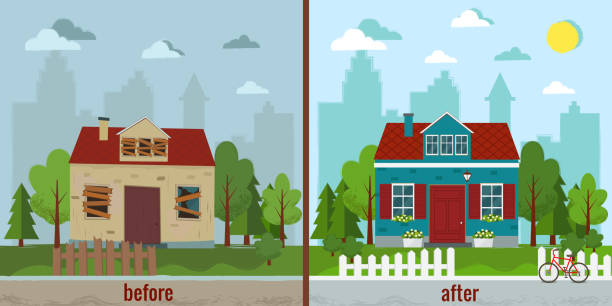
13 Oct BRRRR is Like Flipping, Except You Get to Keep the House
Flipping a house can be a lot of fun. You go treasure hunting for a fixer upper. You put together your renovation plan, pick out the materials, transform the house inside and out, and then (hopefully) sell the house for a tidy profit. It feels great to see the house go from dated and obsolete to fresh and modern. Getting that check from the title company at the end is a wonderful feeling.
Flipping is possible for many people. There are a lot of lenders out there who can finance a fix and flip project. If you’re low on cash, there are creative ways to make a deal work. You can bring in a partner who supplies the money, or perhaps have a partner who does the renovation work. Hard money lenders are everywhere, so you might not even need a partner.
When you sell a house in less than a year after buying it, your profit is taxed at your ordinary income tax rate. If you’re doing well financially, your tax rate could be 22%, up to 37%. Those taxes will eat into your gains significantly. If you haven’t set aside some of your proceeds for taxes, next April 15th you could be feeling some stress when you have to write checks to the federal, state, and local tax authorities. (Technically, if you earn more than $1,000 you need to make quarterly tax payments. Read our article about taxes for flippers.)
With flipping, you get your original money plus profit back in a matter of weeks or months. You make money on the value you created for someone else. But what if you could get your original money back, plus keep the house and be able to collect rent? And count depreciation as an expense to lower your tax liability even more? That’s where BRRRR could be a better option for you.
BRRRR stands for Buy, Renovate, Rent, Refinance, and Repeat. You buy a fixer upper in cash, improve it, rent it out, do a cash-out refinance to hopefully pull out your entire original cash investment, and then use that cash to buy the next house. I go through a textbook BRRRR deal in this blog: https://investandtransform.com/anatomy-of-a-brrrr-deal-its-like-playing-with-house-money/. By the way, after that blog was written, my wife Amira and I bought another house with that money, pulled the cash out, and bought another house with the same money. All of the houses are rented and producing cash flow.
Flipping = Buy low, improve the house, sell high, get your original investment back + profit. You pay lots in taxes; you no longer own the asset; you miss out on future appreciation; you miss out on depreciation; you miss out on cash flow.
BRRRR = Buy low, improve the house, refinance high, get your original investment back + rent high. You don’t pay taxes on the increase in value because you don’t pay taxes on a mortgage loan; you own the asset; the house appreciates over time; you can book depreciation to lower your tax liability; you receive positive cash flow. Since you renovated the house, you probably won’t spend much on maintenance costs for a while. You can collect market rents or higher because you have one of the best rental products on the market.
Here’s the catch: To do BRRRR in the most effective manner means that you need to have the cash to buy the house and renovate it. With most cash-out refinance loan products, you have to wait six months before pulling your money out so the appraisal comes in at the higher, improved value. Yet for many flippers, the time period from purchase to the sale is about six months anyway.
I flipped or wholesaled somewhere between 200 and 300 houses in my younger days. My biggest regret is not keeping some of those properties. I missed out on the rapid increases in value, the income, and the tax advantages. I am not against flipping; I just am a bigger fan of the BRRRR method and keeping the asset.
Think seriously about where you want to be in 10 years. Flipping done well creates cash. The BRRRR method creates wealth. If you could get your original investment money back on a fixer upper in about six months, and you had a choice between selling the asset or keeping it, then why not keep it?
Check out our video on the BRRRR Method, which includes an actual example!
Tai DeSa is a graduate of The Wharton School of the University of Pennsylvania. He became a full-time real estate investor in 2004 after serving in the U.S. Navy. Tai has made colossal mistakes in investing (and learned some things along the way). He has helped hundreds of homeowners avoid foreclosure through successful short sales. Check out Tai’s books on Amazon.com. Tai may be available for coaching and speaking engagements on a variety of real estate topics. Send an email to tai@investandtransform.com.






No Comments